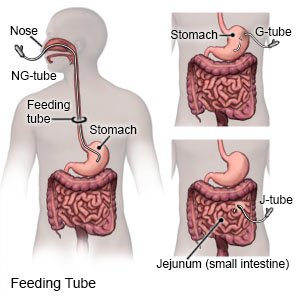Tube Feeding
Medically reviewed by Drugs.com. Last updated on Sep 23, 2025.
What is tube feeding?
Tube feeding, or enteral nutrition, provides your body with nutrients directly into your stomach or intestine. Tube feeding is recommended when you are not able to eat enough to get the nutrients you need. Your tube feeding may be temporary or permanent. Tube feeding can be given through a tube placed in your nose and down into your stomach. This kind of tube is used if you need a feeding tube for less than 6 weeks. Tube feeding can also be given through a tube placed through your abdomen directly into your stomach or intestine. This kind of tube is used if you need a feeding tube for longer than 4 to 6 weeks.
 |
What are the types of tube feeding?
- Intermittent tube feeding is also known as bolus feeding. An amount of formula is given over a short time. The feeding may be given at the same times you would eat breakfast, lunch, and dinner. It may be given only while you sleep. You and your healthcare provider will make a plan that fits into your daily schedule. A feeding pump may be used for feedings. You may be taught how to use a syringe or a free flow bag for feedings.
- Continuous tube feeding is a steady amount of formula being given over a long time. It can be stopped so that medicines or water can be given through your feeding tube. You may need to stop the feeding to check if you are digesting the formula properly. Continuous tube feedings are usually given using a feeding pump. A feeding pump can regulate the speed and amount of tube feeding that is given.
What will happen before I leave the hospital?
You may need to continue tube feedings at home. A healthcare provider will teach you, or someone close to you, how to give tube feeding formula at home. You will learn how to use the equipment and care for your tube. You will learn how to find and fix problems with your tube feeding. A dietitian will decide what type of formula is best for you.
Related medications
What else do I need to know about tube feeding?
- Always wash your hands before touching your feeding tube, formula, or medicine. This lowers the risk of infection.
- Make sure your tube feeding is connected to the correct port on the feeding tube.
- The tube feeding formula should be at room temperature before your feeding. Room temperature formula may decrease your risk for diarrhea. Formula that is too cold or too hot can cause discomfort or destroy nutrients in the formula.
- Care for your feeding tube as directed. Flush your tube with warm water before and after feedings to prevent blockages.
- Sit up during your feeding to avoid reflux and aspiration (movement of tube feeding into your lungs). Remain sitting for 1 hour after your feeding is complete.
- Keep track of how much tube feeding you take in and how much you urinate. Write down any changes in bowel movements. Weigh yourself as directed by your healthcare provider.
- Continue regular mouth care. Use mouthwash 3 to 4 times a day to keep your mouth moist and prevent infection.
- Follow up with your healthcare provider as directed. You will need regular blood and urine tests to monitor your condition.
When should I seek immediate care?
- You have trouble breathing.
- You have severe abdominal pain.
- Your feeding tube comes out.
When should I call my doctor?
- You have a fever.
- You have abdominal pain or cramping.
- You have increased pain during your feeding or when your tube is flushed.
- Blood or tube feeding fluid leaks from the tube site.
- You have pain at the tube site.
- Your tube is clogged or damaged.
- The skin around your tube is red, warm, and swollen.
- You have constipation, nausea, vomiting, or diarrhea.
- You have questions or concerns about your condition or care.
Care Agreement
You have the right to help plan your care. Learn about your health condition and how it may be treated. Discuss treatment options with your healthcare providers to decide what care you want to receive. You always have the right to refuse treatment. The above information is an educational aid only. It is not intended as medical advice for individual conditions or treatments. Talk to your doctor, nurse or pharmacist before following any medical regimen to see if it is safe and effective for you.© Copyright Merative 2025 Information is for End User's use only and may not be sold, redistributed or otherwise used for commercial purposes.
Further information
Always consult your healthcare provider to ensure the information displayed on this page applies to your personal circumstances.
